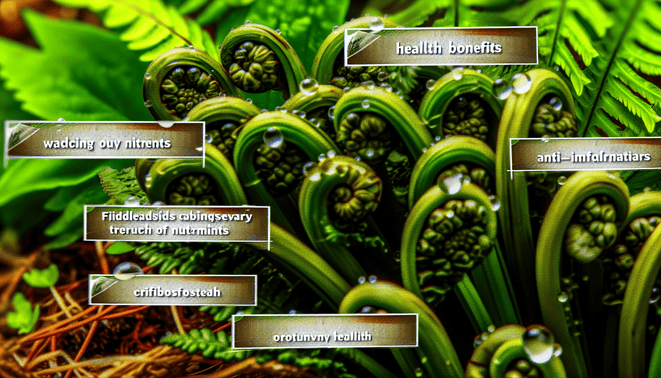Fiddlehead Health Benefits: Discover Their Nutritional Power!
Understanding Fiddleheads: A Unique Culinary Delight
Fiddleheads are the young, coiled fronds of ferns, particularly the ostrich fern (*Matteuccia struthiopteris*), which are commonly harvested in the spring before they unfurl. Their intricate spiral structure not only draws the eye but also offers a distinctive grassy flavor that many liken to a mix of asparagus and spinach [Source: Food Network]. Rich in nutrients, fiddlehead ferns are not only visually appealing but also a healthy addition to any diet. They contain high amounts of vitamins A and C, iron, and dietary fiber, all contributing positively to immune function and digestive health [Source: Healthline].
The Plant Structure and Identification of Fiddleheads |Fiddlehead Health Benefits
Fiddleheads emerge from the fern’s rhizome, an underground stem, which helps facilitate vegetative reproduction. Each fiddlehead is encased in a protective brown sheath that keeps the developing leaf safe until it is ready to unfurl [Source: Gardening Know How]. Understanding how to identify fiddlehead ferns is crucial, as not all ferns are safe to eat; some can be toxic and harmful to humans [Source: Britannica].
Cooking Fiddleheads: Preparation Methods
Fiddleheads can be prepared in various culinary ways, such as steaming, sautéing, or adding them to soups and salads. It’s essential to cook fiddleheads thoroughly, as raw ferns can carry toxins that cooking eliminates [Source: Fine Cooking]. Popular methods for preparation often bring out their nutty flavor, enhancing their appeal among chefs and food enthusiasts alike [Source: Nourished Kitchen].
Nutritional Content and Health Benefits of Fiddleheads
Nutritionally, fiddleheads provide a wealth of benefits, being low in calories yet rich in essential nutrients. A serving of cooked fiddleheads contains approximately 35 calories, 4 grams of carbohydrates, and nearly 2 grams of protein [Source: Healthline]. They are also a great source of omega-3 fatty acids and antioxidants, which may help reduce inflammation and lower the risk of chronic diseases [Source: PubMed].
Varieties of Fiddlehead Ferns: A Closer Look
Among the most recognized fiddlehead species are the **Ostrich Fern** (*Matteuccia struthiopteris*) and the **Royal Fern** (*Osmunda regalis*). The Ostrich fern is the most commonly consumed variety, identifiable by its unique fiddle-shaped heads and tender texture [Source: Healthline]. On the other hand, the Royal fern, although less popular, is still edible and offers a slightly nuttier flavor. Both types should be cooked well to eliminate any potential toxins [Source: NCBI].

Fiddlehead Ferns and Cardiovascular Health
The health benefits of fiddleheads extend to heart health. Their high potassium content is essential for maintaining healthy blood pressure levels, making them a valuable addition to a heart-healthy diet [Source: Healthline]. Additionally, the antioxidants and omega-3 fatty acids aid in reducing inflammation and promoting vascular health. Regular consumption of fiddleheads may contribute positively towards reducing the risk of heart disease [Source: PubMed].
How to Forage and Harvest Fiddleheads Safely
Foraging for fiddleheadshttps://agrownets.com/wp-admin/post.php?post=4178&action=edit can be an enjoyable experience, but it is crucial to do so safely and responsibly. Familiarizing yourself with safe foraging practices—such as identifying the correct fern species and knowing the best harvesting techniques—is essential for an enjoyable culinary experience [Source: Foodal]. Always ensure you are only harvesting from pristine areas and taking care not to overharvest a single location.
Fiddleheads in Culinary Traditions: Regional Uses and Popular Dishes
Fiddleheads are embraced in various culinary traditions around the globe. In North America, they are often featured in Native American recipes and are gaining popularity in modern cooking, especially among those focused on sustainable dining. In Asian cuisine, especially in Japanese dishes, fiddleheads are prepared as tempura or incorporated into salads [Source: Eater].
Fiddlehead Storage and Preservation Techniques
Once harvested, fiddleheads should be stored in the refrigerator in a breathable bag or container and consumed within a few days for the best taste and freshness. They can also be preserved by freezing or pickling, allowing enjoyment beyond the short harvesting season [Source: Eatwild].
Conclusion: Embracing Fiddlehead Ferns in Your Diet
Fiddleheads offer a unique and flavorful way to enjoy seasonal greens. Their nutritional benefits and versatility in the kitchen make them an excellent addition to a healthy diet. As you venture into spring foraging, remember the health benefits associated with these delicate ferns, and ensure you know how to prepare and enjoy them safely [Source: The Kitchn]. Explore the culinary versatility and the impressive health-promoting properties of fiddleheads, enriching both your meals and your wellbeing.
Sources
- Britannica – Fiddleheads
- Eater – Fiddlehead Fern Recipes
- Eatwild – Fiddleheads
- Foodal – The Fiddleheads
- Food Network – What are Fiddleheads?
- Fine Cooking – Cooking with Fiddleheads
- Healthline – Fiddleheads Nutrition
- NCBI – Fiddleheads and Health
- The Spruce Eats – Fiddleheads
- The Kitchn – How to Cook Fiddlehead Ferns